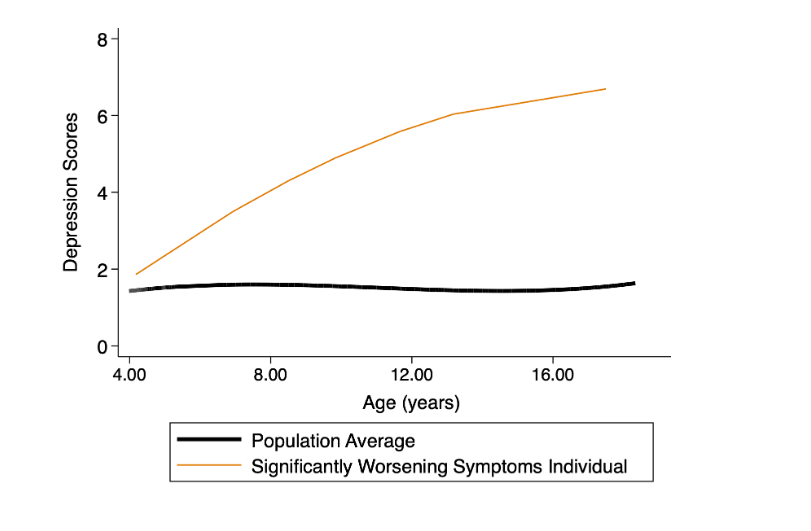A team I’ve been collaborating with is developing a tool to enable easy analysis of longitudinal data. The work, funded by Wellcome is being done on depression and anxiety symptoms, but could in fact be used for any kind of data. The idea is to make it really easy to get nice growth curves, illustrating developmental change, from datasets with at least 3 time-points of repeated measurement. As a further prong to its bow, a next step would be that the tool could also provide additional information. It could identify when someone is getting significantly worse compared to the general trajectory, as illustrated in the figure below. Similarly, the model could specify the age when the greatest increase of symptoms typically takes place. In time, we hope to extend the project so we can model change over time in more than one area of mental health. I was reflecting that I can see three ways in which this tool might be useful in the relatively near future that could have real impact.
 First, researchers in organisations without specialist expertise in growth curve analyses will be able to use the tool to explore longitudinal research data to ask questions about risk factors, heterogeneity and outcomes. Wellcome themselves have identified many potential “active ingredients” that could be explored using this kind of tool. This could facilitate longitudinal research in populations and locations where this has previously not been possible.
First, researchers in organisations without specialist expertise in growth curve analyses will be able to use the tool to explore longitudinal research data to ask questions about risk factors, heterogeneity and outcomes. Wellcome themselves have identified many potential “active ingredients” that could be explored using this kind of tool. This could facilitate longitudinal research in populations and locations where this has previously not been possible.
 Second, this might become useful for identifying young people at risk in secondary schools. Preliminary work has identified that at around age 14 is the period of greatest worsening of emotional symptoms. If it were possible to have pupils complete brief screening scales in years 7, 8 and 9 this might enable early identification of those in need of greater support.
Second, this might become useful for identifying young people at risk in secondary schools. Preliminary work has identified that at around age 14 is the period of greatest worsening of emotional symptoms. If it were possible to have pupils complete brief screening scales in years 7, 8 and 9 this might enable early identification of those in need of greater support.
Third, clinicians have expressed interest in this tool as a way of identifying patients who are not responding as might be expected to a treatment. By detecting those who deviate from the typical reduction seen, it might be possible to identify earlier those at risk of a poor outcome for whom additional support is needed.
It is exciting to see this type of work, essentially figuring out how to make research methods easier to apply in the real world. We know that rates of common mental health conditions, particularly anxiety, are higher than ever before in our young adults. This is unlikely to improve given what our children have endured throughout the pandemic and with the cost of living crisis to name just two factors. I very much hope this can be used to ensure we get help to where it is most needed more rapidly than was previously possible.


